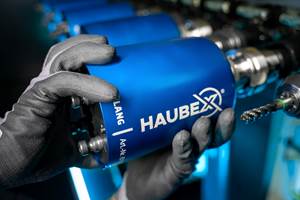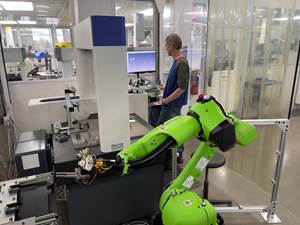Automation Onward
Numerous factors suggest that machine-tending robots will soon be much more commonplace in U.S. shops.
Results from our 2014 Top Shops benchmarking survey indicate an increased use of machine-tending robots among successful U.S. shops. In the previous two surveys, the percentage of shops in our benchmarking group that had integrated such automated processes was in the 16- to 17-percent range. This year’s survey revealed a significantly higher number of shops in that group had robots: 22 percent. (We’ll provide a full report about the survey later in the year.)
This parallels statistics recently provided by the Robotic Industries Association (RIA), which reveal two consecutive years of record robot shipments in North America. In 2013, 22,591 robots valued at $1.39 billion were shipped to North American companies, beating the 2012 record of 20,328 robots valued at $1.29 billion.
FANUC is no stranger to the advantages of automated processes, as is evident at its expansive manufacturing campus in Oshino-mura, Yamanashi, Japan, which I recently re-visited. There, more than 2,500 robots help manufacture other robots, control and drive components, and related equipment. In fact, repeatable, reliable automated processes enable the company to manufacture a whopping 125,000 servomotors each month. Although Japan is a high-wage country, automation enables FANUC to be globally competitive with its CNC and automation products.
During my visit, I spent time with Rick Schneider, president of FANUC America, who has extolled the advantages of automation for years. A decade ago, he launched the “Save Your Factory” campaign, urging North American manufacturers to recognize that, compared to offshoring, improving manufacturing efficiency here through automation, robotics and lean manufacturing is a more cost-effective and profitable alternative. The company continues its efforts to get this message out today. In fact, Mr. Schneider points to the following few factors that, like the data mentioned above, indicate that robots will become more commonplace in U.S. manufacturing facilities.
• Reshoring is real. The 2014 Top Shops survey asked if shops had won work during the previous year as a result of customers’ reshoring efforts, and 15 percent of them said they had. This supports anecdotal evidence I’ve encountered that indicates reshoring is on the rise. Mr. Schneider concurs, saying North American manufacturers today are more closely considering the actual cost of production abroad as, for example, shipping costs and labor rates in China continue to rise. These and other offshoring drawbacks are spurring an increasing number of North American companies to bring production back from overseas and closer to their consumers here. The key to taking advantage of this trend is to optimize production efficiency. For machine shops, this means increasing spindle up-time, and robotic automation offers an effective, reliable means to do that.
• Robot technology is advancing. Today’s robots are faster and more intelligent than in years past, and are becoming increasingly viable for small-batch/high-mix production. Mr. Schneider points to advancements in vision technology as exemplified by high-speed, high-definition cameras that offer improved part recognition capability for picking operations. Offline robot programming tools are becoming more powerful and intuitive, too. In addition, collaborative robots, those that are said to operate safely near humans, might also encourage shops to more closely consider automation. Collaborative robots use advanced force sensing technology to enable them to safely work alongside people without traditional safety fencing. Sensors detect if the robot unexpectedly makes contact with a person, and immediately stops the robot’s motion to prevent worker injury.
• Automation creates a quality workforce. Automation can lead to modest pruning of personnel who lack the desire to grow their skills. Conversely, it presents opportunities for others who are motivated to advance, and can ultimately lead to additional hiring. Automated machine shops require robot cell attendants, programmers and maintenance technicians. These are quality positions that can be filled by retrained people who previously loaded and unloaded machines. Those who improve their skillsets become higher-value assets for a company. They also are more likely to be committed to the business, knowing they possess the level of skills that provide greater job security. And it doesn’t hurt that their paycheck is bigger, too. Of course, this requires an investment in training, but shops that are proactive enough to employ automation likely are also willing to develop effective internal training procedures.
Examples of automation being applied at successful shops are found in our Robots and Automation Zone. Automation will also have a large presence at IMTS with the return of the Industrial Automation North America show, which launched at IMTS 2012. Take advantage of these and other resources and closely consider how you might leverage automation to grow your business, develop a more talented and valuable workforce, and better position your shop to win work that is returning to our shores.
Related Content
Using the Toolchanger to Automate Production
Taking advantage of a feature that’s already on the machine tool, Lang’s Haubex system uses the toolchanger to move and store parts, making it an easy-to-use and cost-effective automation solution.
Read MoreLean Approach to Automated Machine Tending Delivers Quicker Paths to Success
Almost any shop can automate at least some of its production, even in low-volume, high-mix applications. The key to getting started is finding the simplest solutions that fit your requirements. It helps to work with an automation partner that understands your needs.
Read MoreFearless Five-Axis Programming Fosters Shop Growth
Reinvestment in automation has spurred KCS Advanced Machining Service’s growth from prototyping to low-and mid-volume parts. The key to its success? A young staff of talented programmers.
Read MoreBeyond the Machines: How Quality Control Software Is Automating Measurement & Inspection
A high-precision shop producing medical and aerospace parts was about to lose its quality management system. When it found a replacement, it also found a partner that helped the shop bring a new level of automation to its inspection process.
Read MoreRead Next
3 Mistakes That Cause CNC Programs to Fail
Despite enhancements to manufacturing technology, there are still issues today that can cause programs to fail. These failures can cause lost time, scrapped parts, damaged machines and even injured operators.
Read MoreThe Cut Scene: The Finer Details of Large-Format Machining
Small details and features can have an outsized impact on large parts, such as Barbco’s collapsible utility drill head.
Read More
.jpg;width=70;height=70;mode=crop)




.png;maxWidth=300;quality=90)

















